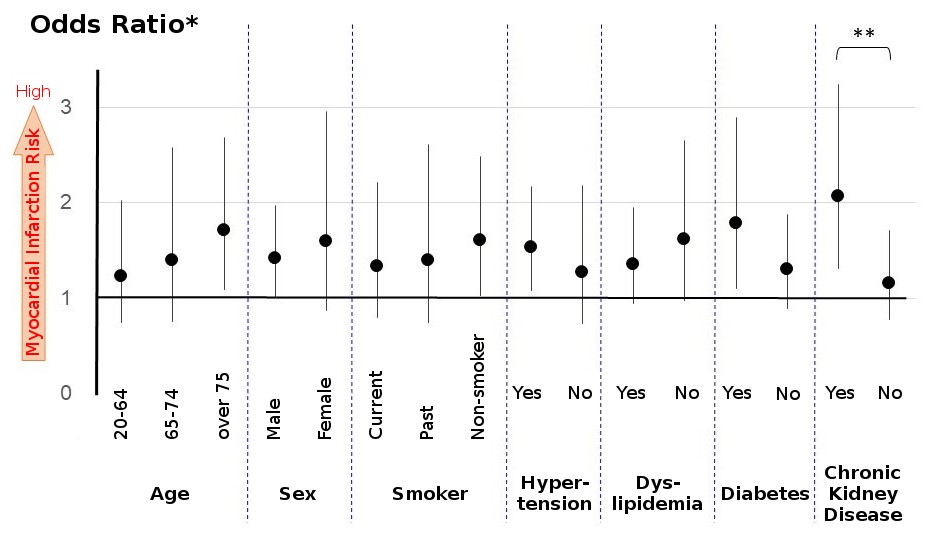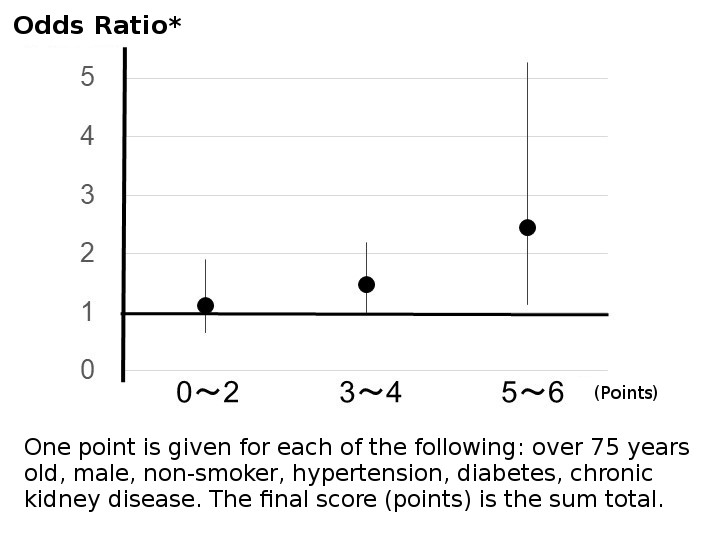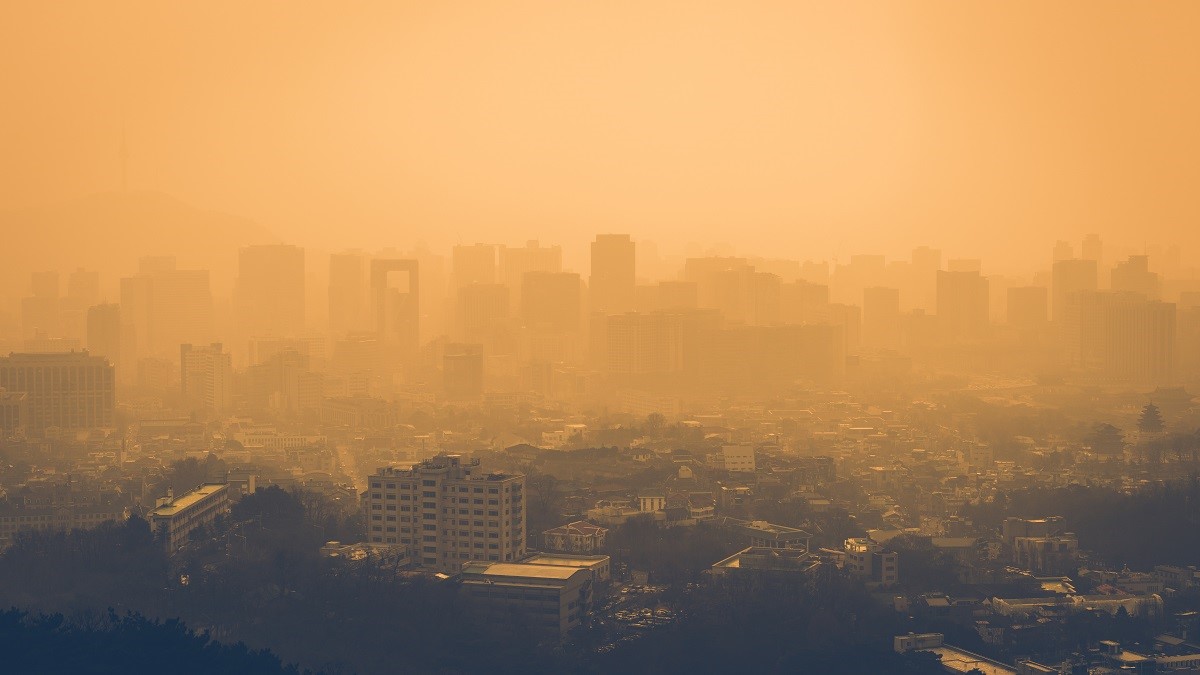Incidence of acute myocardial infarction may increase the day after Asian dust exposure
A recent environmental epidemiological study by Japanese researchers has shown that Asian sand particles blown to Japan from desert areas of the Asian continent are associated with the onset of myocardial infarction. In particular, the research reveals an increased likelihood that patients with chronic kidney disease are susceptible to myocardial infarction when influenced by Asian dust. The accumulation of knowledge on health aspects susceptible to the influence of Asian dust is expected to lead to the prevention of adverse health effects.[Background]
The yellow sand in the desert area of the Asian continent (ex: Gobi Desert, Takla Makan Desert) is sometimes picked up and transported long distances with the seasonal wind. Since air pollutants and microorganisms adhere to the yellow sand during transportation, adverse health effects from dust exposure is a great concern. In Japan, allergies, respiratory diseases, and cardiovascular diseases are reported to increase as the dust passes over the nation. Cardiovascular diseases in particular are associated with an increase in Asian dust in Japan.
For this reason, a Japanese research group focused on acute myocardial infarction among cardiovascular diseases. In the southwestern region of Japan, on the island of Kyushu, Asian dust is observed relatively often. At Kumamoto University Hospital, in the middle of Kyushu, cases of acute myocardial infarction are comprehensively registered in a medical database. Since background factors (i.e., age, sex, hypertension, diabetes, dyslipidemia, smoking, chronic kidney disease, etc.) of patients with acute myocardial infarction are also registered in the database, it is possible to determine what factors are most susceptible to Asian dust. The researchers used this database to analyze the relationship between the dust and acute myocardial infarction.
[Research Data]
The Japan Meteorological Agency announces incidents of Asian dust when an observer visually confirms that the air is turbid with Asian dust particles and the distance visible with the naked eye becomes less than 10 km (http://www.jma.go.jp/en/kosa/). During the research period from April 2010 to March 2015, there were 41 days in the Kumamoto district meteorological observatory that observed Asian dust.
During the study period, there were 4,509 acute myocardial infarction patients registered in the database with clear onset dates. After excluding those who lived outside Kumamoto Prefecture, those who developed acute myocardial infarction during hospitalization or on holidays, or those who lacked patient background information, 3,713 people were analyzed for an association between exposure to Asian dust and the onset of acute myocardial infarction. The research design ignored risk factors for acute myocardial infarction, including, but not limited to, age, gender, hypertension, diabetes, dyslipidemia, smoking, and chronic kidney disease. The statistical model was also adjusted for weather factors (temperature and humidity) which varied depending on the day.
[Results: Acute myocardial infarction increases the day after incidents of Asian dust.]
The odds ratio (approximate value of relative risk) of developing acute myocardial infarction the day after an Asian dust incident was 1.46, with a 95% confidence interval of 1.09 - 1.95. Therefore, the association between the increased numbers of acute myocardial infarction patients after an observation of Asian dust is clear. This association is not changed even when considering the influence of air pollutants such as microparticulate materials (PM 2.5), photochemical oxidants, nitrogen dioxide, or sulfur dioxide.
Next, researchers examined the relationship between Asian dust and myocardial infarction after grouping by patient background factors (age, sex, hypertension, diabetes, dyslipidemia, smoking, and chronic kidney disease). It was found that the association between Asian dust and acute myocardial infarction was most prevalent in nonsmoking* male patients older than 75 years old with hypertension, diabetes, and chronic kidney disease. Among that cohort, it was clear that patients with chronic kidney disease were significantly more likely to suffer from acute myocardial infarction after being influenced by dust than those without chronic kidney disease.
*This study investigated background factors that make it easy for acute myocardial infarction to occur under the influence of Asian dust and showed that nonsmokers may be more susceptible. However, smoking is not recommended to prevent the occurrence of acute myocardial infarction caused by dust since it is clear that smoking itself is a risk factor for acute myocardial infarction from many other epidemiological studies. The researchers believe that people should first avoid smoking to avoid the risk of acute myocardial infarction rather than being concerned with exposure to Asian dust.
To investigate whether there were more background factors susceptible to Asian dust, the researchers assigned 1 point for each of several categories: over 75 years of age, sex (1 point for being male), high blood pressure, diabetes, non-smoker, and chronic kidney disease. Patients with higher group scores (5 to 6 points) were shown to be more susceptible to Asian dust.
[Discussion and Future Prospects]
It is not yet known how much (or even how) yellow dust exposure is involved in the process of developing myocardial infarction. Even though adjustments were made to the concentration of air pollutants such as photochemical oxidants, nitrogen dioxide, and sulfur dioxide to eliminate their effects on the statistical model, the relationship between Asian dust and acute myocardial infarction remained. Asian dust consists of both relatively large particles and PM 2.5, which has been associated with acute myocardial infarction. Since the concentration of PM 2.5 was already high at the time of arrival of the Asian dust, researchers also analyzed its effects by excluding the influence of PM 2.5. The association was seen there as well meaning that particles with larger diameter than PM 2.5 may also be affected. Additionally, in patients with chronic kidney disease, adverse reactions such as oxidative stress or inflammation are progressing in the body so exposure to the Asian dust may bolster these reactions thereby causing acute myocardial infarction.
"Our research suggests that exposure to Asian dust may trigger the onset of acute myocardial infarction. As far as we know, this is the first report showing that patients with chronic kidney disease may more easily develop acute myocardial infarction when influenced by Asian dust," said Associate Professor Sunao Kojima of Kumamoto University, leader of the study. "This time, we assessed patients only on the days when the Japan Meteorological Agency reported Asian dust in our region. In the future, it will be necessary to estimate the concentration of Asian dust in the air and examine whether acute myocardial infarctions increase as the concentration increases. We also intend to accumulate knowledge on background factors that are susceptible to the influence of Asian dust at various concentrations to try and prevent the adverse health effects of Asian dust."
This research result was presented at the Hot Line of the European Cardiology Society held in Barcelona, Spain, at 11:30 AM (local time) on 29 Aug. 2017, and posted online in the "European Heart Journal 2017" on 29 Aug. 2017.
*The views expressed in this research are those of researchers, not of the Japan Ministry of the Environment.
[Resource]
Kojima, S.; Michikawa, T.; Ueda, K.; Sakamoto, T.; Matsui, K.; Kojima, T.; Tsujita, K.; Ogawa, H.; Nitta, H. & Takami, A., Asian dust exposure triggers acute myocardial infarction, European Heart Journal, Oxford University Press (OUP), 2017.
DOI: 10.1093/eurheartj/ehx509
[Paper Info]
TITLE:
Asian dust exposure triggers acute myocardial infarction.
AUTHORS:
Sunao Kojima, Takehiro Michikawa, Kayo Ueda, Tetsuo Sakamoto, Kunihiko Matsui, Tomoko Kojima, Kenichi Tsujita, Hisao Ogawa, Hiroshi Nitta, Akinori Takami.
JOURNAL:
European Heart Journal 2017
DOI:
10.1093/eurheartj/ehx509
URL:
https://academic.oup.com/eurheartj/article/doi/10.1093/eurheartj/ehx509/4096402/Asian-dust-exposure-triggers-acute-myocardial#95751924
[Fund]
Environment Research and Technology Development Fund of the Ministry of the Environment of Japan (in part) (5-1452)
Grants-in-Aid for Scientific Research from the Japan Society for the Promotion of Science of Japan (in part) (17K19821)
The Foundation for Total Health Promotion, Japan (in part).
[image1]

Relationship between Asian dust and myocardial infarction by background factor on the day before onset of myocardial infarction
CAPTION:
The higher the odds ratio, the higher the risk of myocardial infarction. Adjusted for Asian dust, temperature, and humidity on the day of and 2 to 5 days before myocardial infarction. The relationship difference between dust and acute myocardial infarction is statistically significant depending on the presence or absence of chronic kidney disease.
[image2]

Relationship between Asian dust and myocardial infarction when background factors are combined
CAPTION:
Adjusted for Asian dust, temperature, and humidity on the day of and 2 to 5 days before myocardial infarction. Odds ratio 2.45, 95% confidence interval 1.14 - 5.27. Please note that scoring by background factor was developed for this research project and it is necessary to conduct a separate verification.
[image3]

Asian dust
CAPTION:
Asian dust has been reported to result in a variety of health hazards.
<For all Images>
[Image details]
CREDIT: Dr. Sunao Kojima
USAGE RESTRICTIONS: This image may only be used in conjunction with the accompanying release, or stories written about the work described in the release with reference to the original work.

